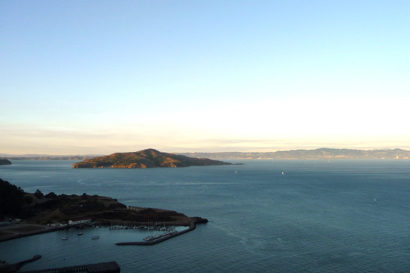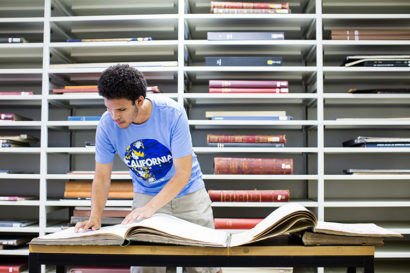To recover from next big quake, start today
While most Bay Area residents know a big earthquake is predicted to strike the region in the next two or three decades, many are unprepared.
November 23, 2016
Seismologists with the U.S. Geological Survey recently discovered that the Hayward Fault, considered the most dangerous fault in the San Francisco Bay Area, is connected to another — the Rodgers Creek Fault — under San Pablo Bay. If the two faults ruptured simultaneously, it could cause major devastation.

The USGS recently discovered that the Hayward Fault and Rodgers Creek Fault connect under San Pablo Bay. (Photo by samkinsley via Flickr)
While most Bay Area residents know a big earthquake is predicted to strike the region in the next two or three decades, many are unprepared. Berkeley News spoke with Mary Comerio, an expert in disaster recovery and reconstruction and a professor in the College of Environmental Design at UC Berkeley, about what stops us from preparing and how to plan for the big quake.
Berkeley News: How prepared is California for the big earthquake?
Mary Comerio: We’re better in California than in most places because we had these little wakeup calls. In 1989 in the Bay Area, and Northridge in 1994 in Southern California — they got people’s attention. But really, it took until this last round of international events, all the earthquakes that started happening around 2008, 2010, in Japan, in New Zealand, Chile… in developed countries. And then people thought, “It could happen here.”

The Marina District in San Francisco after 1989’s Loma Prieta earthquake (Photo by Eve Fraser-Corp via Flickr)
We’re probably as well-prepared here in the Bay Area as anyone in the world, but we still have a long way to go to deal with things like this.
We are going to have a major earthquake in an urban area at some point in the future. And when we do, we are going to have a whole lot of people with huge mortgages and no way to pay for the repairs. And that’s going to be a very serious public policy issue. We could see the kinds of foreclosures we saw in the 2008 financial crisis. And would there be a federal bailout of some kind? Who knows? It totally depends on the politics of the time.
What does it take to be prepared for a disaster?
I always say there are two parts to disaster preparedness. One is the physical stuff — making buildings and bridges stronger, that sort of thing. Then there’s the administrative stuff, which is thinking about what issues are going to come up in your situation, your business, your government agency, and then making a plan. Planning is cheap. All you have to do is sit around a table and think about it. Write it down. Rehearse it. It’s hard to get people to do that.
Why is it so hard to get people to plan?

A question of long-range planning: Brace your house’s foundation? Or braces for your child’s teeth? (Photo by егiк етi ѕмiт via Flickr)
There’s always something more politically pressing. The earthquake might happen tomorrow or it might happen in 25 years. Politicians are hoping it won’t happen on their watch. Why should they spend money on something that’s not going to get them brownie points with the electorate, whereas if they do a tax rebate or some other social program, it’s going to have a direct impact on voters?
The same goes for families. Should you brace your house’s foundation or get braces for your kid’s teeth? It’s why it’s so hard to get people to do long-range planning.
How can individuals prepare now to become more resilient?
Think about your situation and make a plan. Think about where you live, where you work, where your children are in school. What sort of risks might your family encounter? And how would you deal with that? How would you deal with it if one of your kids had their apartment building collapse? Or their dorm? Do you have hazardous conditions?
You don’t have to do everything all at once, but thinking about it — taking some time to step back and think about it and decide which things you can tackle — is important. At least you’re thinking about it.
What needs to change for people to sit down and actually make a plan?
Incorporating disaster recovery into larger planning and broader thinking — the things you do to make a place, a city, a country, a government, a state better. It can’t just function for something that might happen in 20 years; it actually needs to do some good now. So policies need to have social benefits in the present as well as reducing the risks over the long term.
And if you do that, you make recovery easier. You make it less problematic, less damage to begin with. That involves changing building codes and planning attitudes. You know, not letting people build in floodplains. It’s a very slow process, but if I look back 20 or 30 years, I see huge amounts of progress. But is it anywhere near where I’d like it to be? No. It’s like being on a crusade. I just keep trying to make it a little better.
What work is happening now in the field of disaster recovery?

Comerio says her students in the College of Environmental Design will train the next generation in disaster recovery. (UC Berkeley photo by Elena Zhukova)
The most exciting work is what’s coming out from recent Ph.D. students. They blend engineering modeling with city planning modeling about growth, and then being able to show how they can gain risk reduction through certain kinds of city policies or urban planning policies. We’re beginning to develop a more sophisticated and linked way of modeling that is helping to demonstrate the benefits of this kind of thinking and planning. And my students are getting jobs in major universities, which means they will be training the next generation.
Mary Comerio is an expert in disaster recovery and reconstruction and a professor in UC Berkeley’s College of Environmental Design.
